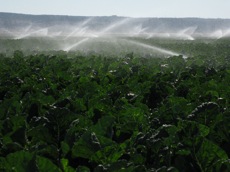
We’d like to think that weather and water supply is a straightforward proposition. If rain falls in the lowlands and snow blankets the Sierra Nevada the way we expect it to, then we ought to have enough water to get us through the dry months ahead. But of course, California water is never that simple. The latest example: today’s state and federal announcements of projected deliveries from two massive Central Valley water systems.
From the state: The Department of Water Resources said it’s increasing promised State Water Project deliveries from five percent–the amount projected last December 1–to 15%.
In a conference call with reporters, newly-appointed DWR Director Mark Cowin called the 15% figure “very conservative.” He said that if the wet season continues on its current “average” path, the department could deliver between 35-and-45% of the contracted amount. Cowin said where final allocations would land in that range depends on pumping restrictions currently in place to protect endangered salmon and smelt. “That spread between 35 and 45 percent is based on how the fisheries agencies ultimately apply the existing rules to protect fish–and how much resulting flexibility we have to pump water from the Delta,” Cowin said.
The bottom line from the DWR announcement: Three years of drought have taken a toll on water supplies that will take more than one good year of rain and snow to reverse. Cowin says runoff from the healthy Sierra snowpack will be lower than normal, as more water is absorbed by relatively dry soil.
At the same time, the State Water Project’s biggest reservoir, Lake Oroville, stands at 54% of its normal level for this time of year. The other linchpin for SWP supply, San Luis Reservoir, is at 80 percent of normal overall. But most of that water is already spoken for and is unavailable for meeting this year’s state water contract commitments.
As the state was adjusting its projections, officials also weighed in on 2010 deliveries from the federal Central Valley Project.
Secretary of the Interior Ken Salazar announced that the initial allocation from the CVP to San Joaquin Valley farmers and other users is 5%. That’s better than nothing–which was the early allocation last year. But it was only part of the news.
Salazar disclosed that negotiations involving Senator Dianne Feinstein, other members of the California congressional delegation, water contractors, and environmental groups have hammered out a plan that could deliver nearly 40% of contracted supplies to CVP customers. But there’s a big “if” in the picture: Those expanded deliveries only happen if the wet season continues to be wet.
Weeks of controversy preceded Salazar’s announcement. Areas of the San Joaquin Valley that have gone thirsty during the three-year drought–notably the Westlands Water District–have been agitating for more federal water even if it means overriding Endangered Species Act protections for fish.
Feinstein went to bat for Westlands and other federal water customers, proposing an amendment to a jobs bill that would set aside Delta pumping limits in order to guarantee deliveries to Valley water users. That sparked outrage from those working to save the Delta fisheries and a sharply critical letter from a dozen House members. But it also apparently prompted the talks that led to Salazar’s announcement. In a statement, Feinstein said she was pleased with the projected allocations announced today and praised the “creative thinking” that went into it. But she added that she’s watching how water shipments play out. Although she has shelved her water amendment for now, she said, “I reserve the right to bring it back should it become necessary.”
Here’s our updated KQED California Reservoir Watch, which gives a pretty good picture of the state’s water storage:
<
View KQED: California Reservoir Watch in a larger map
One thought on “More Water Likely for Farms and Cities–With a Catch”
-
Pingback: Latest Snow Survey Offers Hope | KQED's Climate Watch
Comments are closed.
